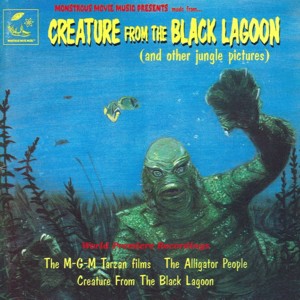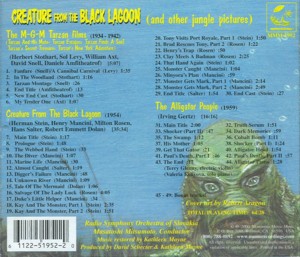| |
The Thunder ChildScience Fiction and Fantasy |
| |
|
| |
|
|
Music CD: Creature From the Black Lagoon (and Other Jungle Movies) by Ryan Brennan
One thing that can be said for the Monstrous Movie Music series is that the creators, David Schecter and Kathleen Mayne, don't glut the marketplace with their merchandise. The first two albums were recorded in 1995 and released the following year in 1996. This third release was recorded in 1998 but not released until 2000. The fourth and fifth albums were also recorded in 1998 but not released until 2005. Though it would be nice to think that there could possibly be more great music already stockpiled and awaiting release at some future date, the economics of running an independent music label, especially one that specializes in a niche market of the already marginalized category of soundtracks, works against it. The bottom line is that when these albums are released they are bountiful treats for the soundtrack collector, meticulously researched and reconstructed, conducted with great affinity for the material by Masatoshi Mitsumoto, beautifully recorded and mastered with superb sound quality, and graced with generous and detailed liner notes that also offer interesting photos and reproductions of score manuscripts. All reasons why every soundtrack collector should support the Monstrous Movie Music releases. Edgar Rice Burroughs' character Tarzan has long been a movie perennial. From the earliest silent version with Elmo Lincoln (1918) to a Disney animated movie and a more recent syndicated live-action TV show, Tarzan has been a longtime audience favorite. The slightly more than five minutes of music presented here is from five of the M-G-M Tarzan films starring Johnny Weismuller. This represents all of the music from the Tarzan films with the exception of source music, a piece from Romeo and Juliet used in Tarzan, The Ape Man (1932), and another piece from the same film titled "Voodoo Dance." The suite begins with a fanfare and seques into a semi-comic piece titled "A Cannibal Carnival." "In The Woodland" is another Monstrous Movie Music premiere, the cue having been cut from Tarzan Escapes along with the vampire bats and killer pygmies that had been shot and then deemed too gruesome and frightening for family audiences. "Tarzan Montage" is in Tarzan's New York Adventure but the :30 cue was shortened in the final film. "New End Cast," from the same film, was among several recordings of different length actually written for Waterloo Bridge (1940). "My Tender One," a pastoral piece that could easily have ended a sagebrush saga, was actually written for Eskimo (1933) and was used to happily end several Tarzan pictures. Creature From The Black Lagoon (1954) was one of the better films presented originally in 3-D and holds up on its own without the gimmick. And, as mentioned above, it also introduced Universal's last important monster. It's been reported that the film is based on a legend of a half-man, half-fish the producer had heard was living in the Amazon. The film story begins with the discovery of a fossilized webbed hand (one of the film's several great 3-D effects as the hand projects out into the auditorium) and the resulting expedition down the Amazon in search of more fossil remains. No one expects what happens, the appearance of a still living prehistoric creature, the same species responsible for the fossil. The success of this film begat two direct sequels -- Revenge of the Creature (1955) and The Creature Walks Among Us (1956) -- and, possibly, inspired other filmmakers to attempt human-size horrors such as a half-man, half-fly, a hideous Sun Demon or the Alligator People. An important aspect of the Monstrous Movie Music series -- besides getting hold of the music -- is the scholarship behind the endeavor. It is not enough for Schecter and company to merely present us with a musical feast. It is important to him that we understand where this came from, how the music department of a major Hollywood studio operated, and thereby clear up mysteries that may have plagued some fans regarding authorship and music use. In this release we learn that the Creature score was typical of its time, a score consisting of 29 original cues and 15 cues which had previously seen service in other Universal films. Additionally, 8 of the original cues were re-used through the picture. The 35:34 of music on this album contains almost all the Creature music that has previously been unreleased (not counting repeats of cues and a few musical bridges connecting tracked in pieces). Herman Stein's distinctive musical style is heard in "Main Title," an organ interlude setting an eerie atmosphere. This served the same purpose for the first sequel, Revenge of the Creature, and some of it was used again for The Creature Walks Among Us. "Prologue," another Stein piece, would have as easily suited It Came From Outer Space or This Island Earth, but here takes us up to that great 3-D effect with the webbed hand and the first shock use of a Creature theme variation, those three trilling notes usually played loudly on trumpets as they are in the next cut, "The Webbed Hand." Stein is well represented in this suite by 8 cues, including "Kay And The Monster" (Parts 1 and 2), "Tony Visits Port Royale, Part 1," recorded as it was heard in City Beneath the Sea (1953), and "That Hand Again." Henry Mancini gets nine cues, many of them beautiful cues depicting underwater scenes like "The Diver" and "Marine Life." Another such piece, "Unknown River," once contained a version of the Creature's theme meant to accompany a shot of it swimming alongside the boat. This was cut but, in one of those great extras that are a regular feature of these Monstrous Movie Music releases, we get the cue both ways, with and without the Creature theme. The longest cue in the suite is "Salvage of the Lady Luck," written by Milt Rosen for City Beneath the Sea. Although never used in its entirety, various pieces were incorporated into both Creature and Revenge of the Creature, a nearly seamless fit occurring thanks to the Rosen's use of the otherworldly Novachord. Another bonus for listeners is the presentation here of the complete 4:05 cue. More Rosen cues are used, with alterations: "Brad Rescues Tony, Part 2," from City Beneath the Sea, "Henry's Trap," from The Glass Web (1953), and "Clay Meets a Badman," from Audie Murphy's Ride Clear of Diablo (1954). The Alligator People (1959) is a Southern Gothic sci-fi tale set in the bayou where Dr. Sinclair performs experiments that turn people into -- surprise! -- alligators. Despite its novel setting and monster, as well as the box office value of casting Lon Chaney, The Alligator People was a commercial failure. The score by Irving Gertz, on the other hand, is another matter. The composer offers a score written with passion and imagination, adding to a flawed film that would otherwise suffer without it. The "Main Title" is given something of a tragic turn in its melody with an unearthly twist in the use of electric violins. "Truth Serum" and "Dark Memories" are two quiet but persistent pieces reminiscent of cues we might hear on The Twilight Zone television program. "Alligator Head" is a frightening, nightmare cue that accompanies the appearance of the full-fledged Alligator man. In "Paul's Death, Part II" the producers are able to correct an error in the original recording, namely to properly synchronize the electric violins which were a full measure behind in the film.
|
|







